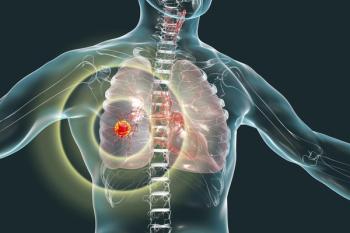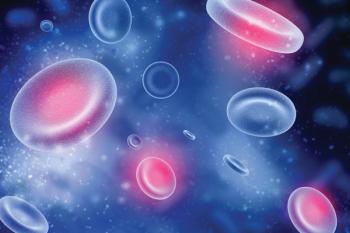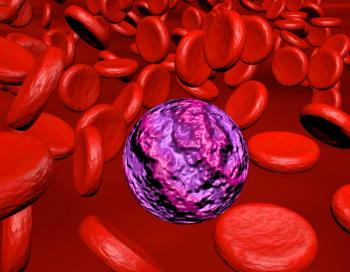
Revumenib Yields Meaningful Benefit in NPM1-Mutated Acute Myeloid Leukemia
Phase 2 data support the potential of revumenib to advance the standard of care for patients with relapsed/refractory NPM1-mutated acute myeloid leukemia.
Treatment with revumenib produced clinically meaningful responses in an older population of patients with heavily pretreated relapsed/refractory acute myeloid leukemia (AML) harboring NPM1 mutations, according to findings from the phase 2 portion of the
Among 64 evaluable adult patients, a complete response (CR) or CR with partial hematologic recovery (CRh) occurred in 23.4% (95% CI, 13.8%-35.7%; 1-sided P = .0014). Additionally, revumenib elicited a composite CR rate of 29.7% (95% CI, 18.9%-42.4%) and an overall response rate (ORR) of 46.9% (95% CI, 34.3%-59.8%). Data showed a median time to first response of 1.84 months (range, 0.9-4.6) and a median time to first CR or CRh of 2.76 months (range, 1.8-8.8). Study treatment produced responses across patient subgroups, although the study was not powered to assess differences in outcomes among these subgroups.
The median duration of CR or CRh was 4.7 months (95% CI, 1.2-8.2), and the median duration of composite CR was 4.7 months (95% CI, 1.9-8.2). Revumenib yielded a median event-free survival (EFS) of 3.0 months (95% CI, 2.0-3.8) and a median overall survival (OS) of 4.0 months (95% CI, 2.5-7.2) across all adult patients. Among those with a CR or CRh, the median OS was 23.3 months (95% CI, 7.2-not reached).
Of 30 patients who achieved a response, 5 (16.7%) had an allogeneic hematopoietic stem cell transplant (HSCT) during remission. Additionally, of these patients, 3 continued treatment with revumenib following HSCT for durations ranging from 2 to 60 weeks; no patients remained on maintenance revumenib at the time of data cutoff. Among those who continued revumenib following HSCT, investigators reported no events of differentiation syndrome, grade 2 or higher corrected QT by Fredericia (QTcF) prolongation, or grade 5 treatment-emergent adverse effects (TEAEs).
“These are impressive, landmark results [that] underscore the potential for revumenib to meaningfully advance the standard of care for patients with [relapsed/refractory NPM1-mutated] AML, a difficult-to-treat disease with a poor prognosis. In the older, heavily pretreated population enrolled in this trial, it is very encouraging to observe that nearly 50% of patients achieved an overall response and that revumenib was generally well tolerated,” lead study author Martha L. Arellano, MD, a professor of hematology and oncology at Winship Cancer Institute of Emory University, stated in a press release on these data.2 “These findings add to the growing body of evidence supporting revumenib’s paradigm-changing potential as treatment for a significant subset of acute leukemias.”
According to the press release, developers completed the submission of a supplemental new drug application (sNDA) for revumenib in this AML population as part of the FDA’s Real-Time Oncology Review program in April 2025. Supporting data for the sNDA came from the phase 2 portion of the AUGMENT-101 study.
In the open-label phase 1/2 AUGMENT-101 study, patients received revumenib at a recommended phase 2 dose of 270 mg (or 160 mg/m2 if their body weight was under 40 kg) once every 12 hours for each continuous 28-day cycle. Study treatment continued until a lack of response after a maximum of 4 cycles, progressive disease, unacceptable toxicity, withdrawal of consent, investigator decision, or loss to follow-up. Those with a composite CR or partial response were eligible to receive allogeneic HSCT without exiting the study.
The trial’s primary end points were the CR plus CRh rate and safety and tolerability. Secondary end points included composite CR rate, ORR, time to response, duration of response, EFS, and OS.
Between October 1, 2021, and September 18, 2024, 84 patients with relapsed/refractory AML harboring NPM1 mutations received at least 1 dose of revumenib and made up the trial’s safety population. The median age was 63 years (range, 11-84), and most participants (98.8%) were adults. Patients received a median of 2 (range, 1-7) prior lines of therapy, and a majority had received prior venetoclax (Venclexta; 73.8%).
The study included a single 11-year-old patient who was not included in the protocol-defined primary efficacy analysis across the adult patients but otherwise met the efficacy-evaluable criteria. This patient had IDH2-mutated disease at baseline, 4 prior lines of treatment, and previous HSCT. Investigators noted a CRh in this patient after treatment for 17.6 weeks; therapy continued for 2 cycles after the response, and the patient experienced a relapse and withdrew consent from the study afterward.
In the safety population, any-grade and grade 3 or higher TEAEs affected 98.8% and 91.7% of patients, respectively; these rates were 78.6% and 59.5% for treatment-related AEs (TRAEs). The most common grade 3 or higher TEAEs or TRAES, respectively, included febrile neutropenia (33.3% vs 13.1%), anemia (25.0% vs 14.3%), and QTcF prolongation (22.6% vs 21.4%).
Ten patients (11.9%) experienced TRAEs resulting in dose reduction, and 4 (4.8%) discontinued revumenib after a TRAE. Investigators noted 1 death (1.2%) due to treatment-related cardiac arrest.
References
- Arellano ML, Thirman MJ, DiPersio JF, et al. Menin inhibition with revumenib for NPM1-mutated relapsed or refractory acute myeloid leukemia: the AUGMENT-101 study. Blood. Published online May 7, 2025. Accessed May 8, 2025. doi:10.1182/blood.2025028357
- Syndax announces publication of pivotal revumenib data in relapsed or refractory mNPM1 acute myeloid leukemia in the journal Blood. News release. Syndax Pharmaceuticals. May 7, 2025. Accessed May 8, 2025. https://tinyurl.com/2y85fban
Newsletter
Stay up to date on recent advances in the multidisciplinary approach to cancer.


















































































